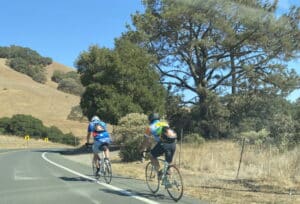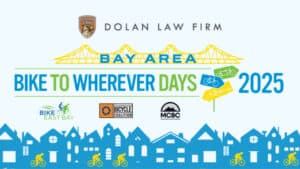Today’s question comes from Jane in Portola Valley who asks, “We were bike riding in Marin and we were going to stop in Samuel P. Taylor Park to have a bite to eat and rest before continuing our ride to Point Reyes. I hit a bump in the road and was thrown from my bike. I landed on my head and suffered pretty bad cuts on my face and shoulder and broke my forearm. The bump was pretty big and wasn’t really visible to me as the sun was directly overhead. After I fell, the police came and the park ranger walked over and said that I wasn’t the only one to fall there. Do I have any legal recourse?”
Jane, your question is not an easy one to answer with so little information because so much of its legal success would depend on facts, such as whether your fall took place inside or outside of park boundaries, a fact which would determine both the relevant agency that might be responsible and the rule for evaluating its responsibility. Whether inside the park or on the highway, your injury occurred on public property and is therefore subject to the “dangerous condition of public property” doctrine, codified in the California Government Code. This doctrine addresses injuries that happen on public property including sidewalks, highways, roadways and the like, and limits the situations under which the government may be held liable for any dangerous conditions.
If you were already within the park’s boundaries, your case would depend on application of the Government Code Section 831.4. Under this rule, the government is not liable for injuries caused by the condition of an unpaved road that is not a city, county, state or federal street or highway and provides access to fishing, hunting, camping, hiking, riding, including animal and all types of vehicular riding, water sports, recreational or scenic areas. Likewise a government entity is immune for injury on any paved trail, walkway, path, or sidewalk on an easement of way which has been granted to a public entity, which easement provides access to any unimproved property, so long as the public entity shall reasonably attempt to provide adequate warnings of the existence of any condition of the paved trail, walkway, path, or sidewalk which constitutes a hazard to health or safety.
In your case, if you were within the park when you were injured, it can be argued that the trail immunity does apply. If that be the case, then a counter argument can be made that the entity had an obligation to provide warning of the condition, since the ranger was aware that others had fallen there before.
If you were not within the park, Government Code Section 835 applies. Liability depends on whether an injured party can prove four elements. First, the relevant property must have been in a dangerous condition at the time of the injury. In your case, since you came upon a bump preexisting on your path, this element appears to be satisfied.
The second and third elements overlap considerably: they both require that, in addition to proving that the dangerous condition actually caused the injury, the injured party must prove that the risk of that type of injury was reasonably foreseeable to the government before the injury occurred. In your case, the bump in the road in fact caused your fall, and it was also reasonably foreseeable to the government that a bump in the road might cause someone to fall. The very reason that a bump in the road is considered dangerous in the first place is largely due to the increased risk of road users falling!
Fourth, an injured party must show that either: (a) the dangerous condition was created by a government employee’s negligent act or omission; or (b) the relevant agency had actual or constructive notice of the dangerous condition a sufficient time prior to the injury to have taken measures to protect against the dangerous condition. This element would likely be at issue in your case.
Government Code section 835.2 defines what constitutes actual and constructive notice. Actual notice is when the entity in fact already knew of the existence of the condition and knew or should have known of its dangerous character. Constructive notice, by contrast, requires the injured party to establish that the condition had existed for such a period of time, and was of such an obvious nature, that the public entity, in the reasonable exercise of due care, should have discovered the condition and its dangerous character. This takes into consideration whether or not the entity had an inspection system which would have, or should have, identified the condition.
In your case, the park ranger admitted that he knew, or had actual notice of, the bump in the road because you were not the first victim of its dangerous character. The determinative questions, therefore, would be: (1) whose jurisdiction the bump was in and, if not the park’s, were they also aware of the prior accidents; (2) how long ago the other accidents had been and when the relevant agency was made aware of their cause; (3) the practical factors involved in making the road safe; and (4) whether the intervening time was sufficient to have taken measures to protect against the dangerous condition.
Finally, an injured party must also defend against the government’s possible counterarguments. For instance, they must prove that the condition was not merely a trivial defect, that it presents a substantial risk of harm. Courts may decide as a matter of law that a condition is trivial and, in many cases, have done so. For example, a court held that a ½ inch deviation in sidewalk panels trivial as a matter of law. However, the only guidance given to the jury in deciding whether a condition rises to the dangerous threshold is rather circular and cryptic: a substantial risk of harm is one which is more than trivial. Therefore, without additional information as the size, shape, height, etc., it is impossible for me to opine in your case whether the bump in the road would be considered trivial or not.
An injured party must also rebut a government defense that the defect was “open and obvious.“ If a dangerous condition is so significant that it would be open and obvious to a reasonably attentive user, then the government can claim that the user was negligent for not seeing and avoiding the condition. In your case, I would need more information to determine whether the “open and obvious” defense would have merit, such as the time of day when this occurred, weather conditions, shadows from trees, and other factors that would have impaired your ability to appreciate the hazard before you hit it.
We have handled hundreds of dangerous condition cases over the years involving bikes, cars, muni trains, sidewalks, escalators, stairs, highways, city streets and the like. Because of the intricacies of the statutes, these cases are quite complex and should only be handled by trial lawyers with significant experience in this area. I suggest that you get photos of the area, including ones showing dimensions with a ruler in place, as well as lighting conditions at the time of your fall, and present those to a trial lawyer who can analyze whether or not you have a case worth pursuing.










